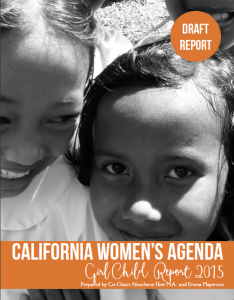GIRL CHILD POLICY
California Women’s Agenda (CAWA) 2010 – 2015
Girl Child Report
CAWA Policy Co-Chair Nourbese Flint M.A.
Following the UN4WCW Platform, the CAWA Task Force
on the Girl Child (Girls and Young Women of California)
agrees discrimination against women begins at the earliest
stages of life, and must therefore be addressed from then
onwards. The girl child of today is the woman of tomorrow.
Her skills, ideas and energy are vital to full attainment
of goals of equality, sustainable development and peace.
For girls to develop their full potential, they need to be
nurtured in an environment where their needs are met,
and their equal rights safeguarded.
The Platform respects and ensures the rights of each child,
irrespective of his or her parents’ or legal guardian’s’ race,
color, sex, language, religion, political or other opinion,
national, ethnic or social origin, property, disability, birth or
status.
See the PDF above for the full report.
Emma Mayerson, CAWA Policy Co-Chair on Girl Child, Executive Director Alliance for Girls
CALIFORNIA WOMEN’S AGENDA, 2005
By Dr. Tam Stevenson
CAWA Girl Child Task Force Co-Chair
Co-Chair: Tonya Williams
The Girl Child
According to the 2000 census, the total population of California was 33, 871,648; 4,505,291 were girls (females under 18 years old).According to Kids Count, a project of the Annie E. Casey Foundation, California ranks 15th out of the 50 states in 10 key indicators of child well-being.
Poverty
• 19% of California children live below the Federal Poverty Level ($18,400 for a family of four in 2003); 6% of California children live in extreme poverty (income below 50% of the FPL). A more accurate measure of a family’s economic well being is the Self Sufficiency Index which shows that basic needs for a family of four in California cost at least twice the FPL.
• 28% of women-headed households in California receive child support or alimony; nationally, 35% do.
Education
• More California students scored below basic reading and math levels given to 4th and 8th graders than the national averages for these standardized tests.
• Between 1996 and 2001 the dropout rate for high school student went from 10% to 8%, a 20% decline.
There is a politically significant movement to assure Universal Pre Kindergarten (UPK) for California’s 3 and 4 year olds. Among the most articulate and powerful advocates for this initiative is California Children and Families Commission’s Rob Reiner. While there are differing opinions about how UPK should be implemented, child advocates are in agreement that it should be done. Please note that there are some powerful and highly politically charged statistics that we could use to challenge the administration’s current education policies. Do you want me to go there? Please advise. TTBS
Health
• 15 % of California children do not have health insurance.
• The Infant Mortality Rate (IMR) for California is 5.4 deaths per 1000 live births. While this figure is an improvement over 1996 data, and better than the national average, there are significant disparities in mortality and morbidity among different populations in California.
• The teen birth rate in California has declined significantly in recent years, from 38 to 24, or 37% between 1996 and 2001, and is now lower than the national average.
The most significant issue in children’s health is the movement to assure that all California children are covered by health insurance. The 100% Campaign and SB 840 (Kuehl) are examples of efforts to assure universal health coverage for California’s children.
Violence
• From October 1, 2003 to September 30, 2004, the most recent period we have data for, there were almost 500,000 referrals to Social Services agencies in California for child abuse; 51% were on behalf of girls.
• In 2001, 18,145 juveniles were detained, incarcerated, or placed in residential facilities.
• In 2002 there were 132,475 juvenile misdemeanor arrests; in 27% of these cases the offender was female.
• In 2002 there were 61,539 juvenile felony arrests; in 17% of these cases the offender was female.
Numbers of juvenile arrests have been declining in California, and nationally, over recent years.
Human Rights
Eliminate all forms of discrimination against the girls and promote and protect their rights
Strategic Actions (from CAWA 1996/2000):
• Ratify the Convention on the Rights of the Child
• Ratify the Convention on the Elimination of All Forms of Discrimination Against Women
To add your voice to the California Task Force Report on Education, send comments on what has happened in your county or region with recommendations to: CAWA Contact

